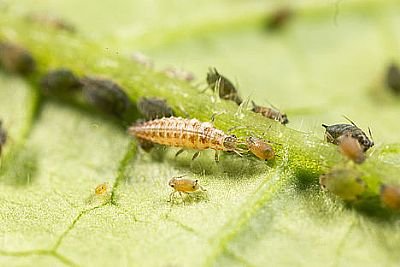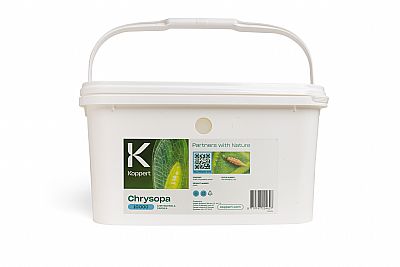CHRYSOPA / Chrysoperla carnea
Lacewing
Target
Use Chrysopa for the biological control of aphids and many other pest insects, like whitefly, thrips and moth eggs. Apply when the pest first appears.
Packing
Chrysopa is sold in bottles or buckets containing larvae (second stage) mixed with buckwheat
-
500 ml bottles contain 1,000 larvae
-
6 litre buckets contain 10,000 larvae
Dosage CHRYSOPA
| Rate (ind./m2) | m2/ unit | Frequency | Interval (days) | Remarks | |
| Preventive | 2 - 5 | weekly | 7 | ||
| Light curative | 5 - 10 | weekly | 7 |
Introduce in
infested areas only
|
|
|
Heavy curative
|
10 - 20
|
|
weekly
|
7
|
Introduce in
infested areas only
|
The information given below is merely indicative. Tailored advice can be provided if information is available on the local factors that need to be taken into account, such as the crop, the climate conditions and the level of infestation. For the correct approach, please consult a specialist of our company.
How does Chrysopa work
Larvae of the lacewing attack prey and suck their body fluids. The remainder of the dead aphid shrivels completely and is difficult to find.
Application Chrysopa
-
Shake the bottle gently before use
-
Apply on infested leaves
-
For curative treatments, apply Chrysopa directly in the heavily affected areas
-
The product can be applied on the rock wool block, on leaves, via Dibox application boxes or distributed by Air(o)bug
Handling
Biological beneficials have a very short life expectancy and therefore need to be introduced into the crop as soon as possible after receipt. Failure to do so can have a negative impact on their quality. In case you do need to store Chrysopa, please follow the instructions below.
Storage
-
Storage after receipt: 1-2 days
-
Storage temperature: 8-10°C/47-50°F
-
In the dark (bottle horizontally)
Pesticides can have (in)direct effects on beneficials. Check here




 HellasSITES
HellasSITES